|
A Comparison
of the Vocal Repertoires
D. Archibald McCallum, Ph.D. MAIN ELEMENTS OF REPERTOIRE
WIFL Song-types
ALFL Song-type
Zweeoo Call
Weeoo Call
Churr and Trill Calls
Call Notes
Double-Peak Call COMBINATIONS OF MAIN ELEMENTS
ALFL Pip + Weeoo
|
SOUNDS
|
1. WIFL Fitzbew
Introduction Table of Contents Back to Reference Page
Recording © Arch McCallum

Figure 1.
WIFL Fitzbew, 6/25/1994, Missoula, Missoula County, Montana.
ã
D. A. McCallum. "P1" = Phrase 1, etc. The phrases are presumed
homologous in Fitzbew and Fizzbew.
|
|
Similar sounds. WIFL Fizzbew: Phrase 1 is a continuously-rising buzzy trill, mirroring Phrase 3. Phrase 2 usually has one isolated click instead of two. WIFL Zweeoo: like a brief Fizzbew but beginning with a series of clicks. Luckily, ALFL Zweeoo is less similar. ALFL Pip-Weeoo: This combination sounds surprisingly similar to Fitzbew. The Pip is continuous, not broken as is "Fitz." The leading part of Weeoo is continuous, not broken into two or three clicks. Despite these differences, and its briefer duration, Pip-Weeoo can cause trouble. |
|
2. WIFL Fizzbew
Introduction Table of Contents Back to Reference Page
Recording © Arch McCallum

Figure 2.
WIFL Fizzbew, 7/10/2007, Deer Lodge, Powell County, Montana.
ã
D. A. McCallum. "P1" = Phrase 1, etc. The phrases are presumed
homologous in Fitzbew and Fizzbew.
|
|
Similar sounds. WIFL Fitzbew: Starts with two loud clicks, and P2 has two isolated clicks instead of one. WIFL Zweeoo: very similar, but noticeably shorter. The similarity is in the first, ascending phrase. In Fizzbew, the "Bew" is long and seems accented, while in Zweeoo the final phrase is short and insignificant. ALFL Feebeeo: Similar enough to confuse; rely on songtype variety in WIFL and ascending second phrase of Feebeeo. If you have very good temporal discrimination, listen for the click in the middle of Fizzbew, which is absent in ALFL Feebeeo. |
|
3. WIFL Creet
Introduction Table of Contents Back to Reference Page
Recording © Arch McCallum
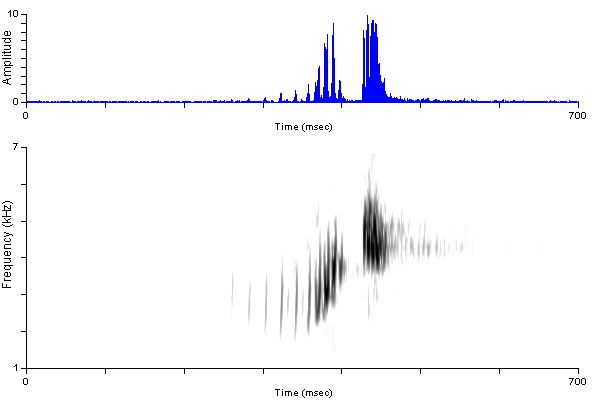
Figure 3.
WIFL Creet, 6/14/2006, Elkton, Douglas County, Oregon. ã
D. A. McCallum.
|
|
Similar sounds. ALFL Zweeoo: Similar in duration and bandwidth, but continuous. WIFL Zweeoo: First phrase is continuous, without break seen above, and it has a second, descending, phrase. ALFL Feebeeo: "Fee" phrase is similar in duration and bandwidth but continuous, and the entire sound is much longer. |
|
4. WIFL Zweeoo
Introduction Table of Contents Back to Reference Page
Recording © Arch McCallum

Figure 4.
WIFL Zweeoo, 7/10/2007, Deer Lodge, Powell County, Montana.
ã
D. A. McCallum .The same bird gave Fitzbew and Fizzbew.
|
|
Similar sounds. Fizzbew: Similar, but noticeably longer in duration then Zweeoo. In Fizzbew, the second phrase ("Bew") starts at a higher pitch than the end of the first phrase ("Fizz"); the second phrase of Zweeoo starts lower than the end of the ascending first phrase. ALFL Feebeeo: Also noticeably longer in duration. The "Fee" and "O" parts are not very different from the two parts of WIFL Zweeoo. It is the middle, "Bee" phrase that sets Feebeeo apart from WIFL Zweeoo. It makes the entire sound longer, and rises to a higher pitch than Zweeoo, giving Feebeeo a more ascending and higher sound. Creet: Creet is similar to first half of Zweeoo, but is broken rather than continuous. WIFL Weeoo and ALFL Weeoo: both resemble second half of this call (see above). |
|
5. WIFL Zweeoo
Introduction Table of Contents Back to Reference Page
Recording © Arch McCallum
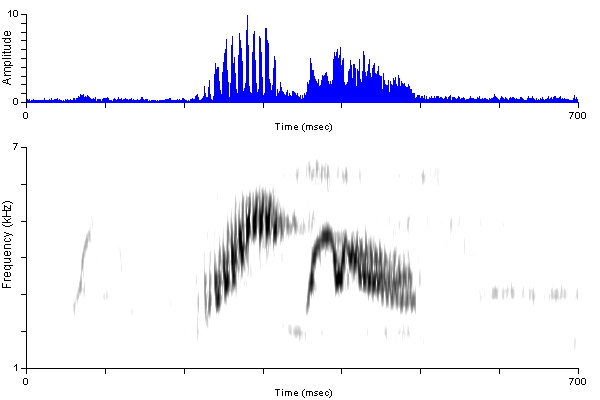
Figure 5.
WIFL Zweeoo, 6/6/2006, Rhinehart Lane, Union County, Oregon.
ã
D. A. McCallum. Numerous Zweeoos and some Whits were heard from
this location. Note the faint Whit (made by a nontarget bird) before the
Zweeoo. It is audible on the cut.
|
|
This example has no leading clicks, and the leading part of the second half is continuous. Otherwise it is similar to the example in Figure 4. |
|
6. ALFL Zweeoo
Introduction Table of Contents Back to Reference Page
Recording © Arch McCallum
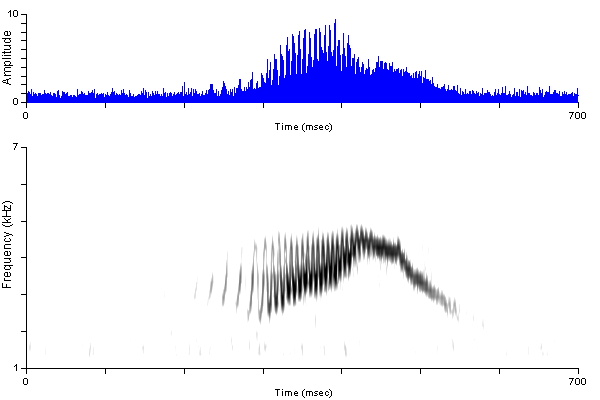
Figure 6.
ALFL Zweeoo, 6/14/1993, Anchorage, Anchorage Borough,
Alaska. ã
D. A. McCallum.
|
|
Similar sounds. WIFL Creet: broken just before the peak. Also, the ascending part is a series of closely-spaced V-shaped notes, while the ascending part of this sound is continuous (i.e., the V's are connected). WIFL Zweeoo: clearly two parted. ALFL Weeoo: ends rather than begins with sawtooth buzzy sound. |
|
7. ALFL Feebeeo
Introduction Table of Contents Back to Reference Page
Recording © Borror Lab

Figure 7.
ALFL Feebeeo, 6/13/1962, Stowe, Lamoille County,
Vermont. Borror Laboratory of Bioacoustics Cut 5900. ã
Borror Laboratory of Bioacoustics, used with permission.
|
|
Similar sounds. WIFL Fizzbew: about the same duration. Listen for the equal-duration ascending and descending pitch trends. Feebeeo rises steadily and then falls suddenly. WIFL Zweeoo is very similar. Its second half is similar in form to the "O" note of Feebeeo, and the two begin similarly. The main difference is that Feebeeo has the "Bee" note and WIFL Zweeoo does not. This gives Feebeeo a much longer ascending arm, and also its peak pitch is higher. |
|
8. ALFL Weeoo
Introduction Table of Contents Back to Reference Page
Recording by Donald Borror, © Borror Lab

Figure 8.
ALFL Weeoo, 8/1/1956, Cutler, Washington County, Maine.
Borror Laboratory of Bioacoustics Cut 2226. ã
Borror Laboratory of Bioacoustics, used with permission. This sound was
extracted from a Complex Call, but it also occurs singly in nature.
|
|
Similar sounds. WIFL Weeoo: has uneven frequency modulation over greater bandwidth, initial part may be sharp-peaked, sounds much rougher. ALFL Churr: lacks the high arching initial part. ALFL Double-Peak: has two smooth Pips instead of one. |
|
9. WIFL Weeoo
Introduction Table of Contents Back to Reference Page
Recording © Borror Lab

Figure 9.
WIFL Weeoo (=Writ-tu), 5/19/1963, Columbus, Franklin
County, Ohio. Borror Laboratory of Bioacoustics Cut 6384 ã
Borror Laboratory of Bioacoustics, used with permission. This is a noisy
recording; WIFL Weeoo is rare in nature.
|
|
Similar sounds. ALFL Weeoo: final part has even frequency modulation, at slightly slower rate, over narrower bandwidth, initial part rounded and drawn out, dominating the sound; sounds more like a Double-Peak than this. Some WIFL Weeoo (see Figure 10) are quite similar to ALFL Weeoo and may not be safely distinguishable aurally. WIFL Double-Peak: has two smooth Pips, the initial Pip here is too brief to register. |
|
10. WIFL Weeoo
Introduction Table of Contents Back to Reference Page
Recording © Arch McCallum
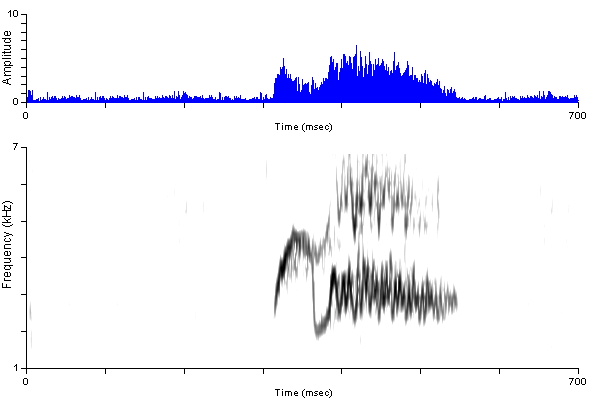
Figure 10.
WIFL Weeoo (=Writ-tu), 7/09/2006, Nutria, McKinley
County, New Mexico. ã
D. A. McCallum.
|
|
Distinguishing features. This example of Weeoo is more rounded at the beginning, and may not be safely distinguishable from ALFL Weeoo. Spectrographically, the longer duration and uneven bandwidth of the buzzy (frequency-modulated) part distinguish it from ALFL Weeoo. |
|
11. WIFL Bew
Introduction Table of Contents Back to Reference Page
Recording © Arch McCallum
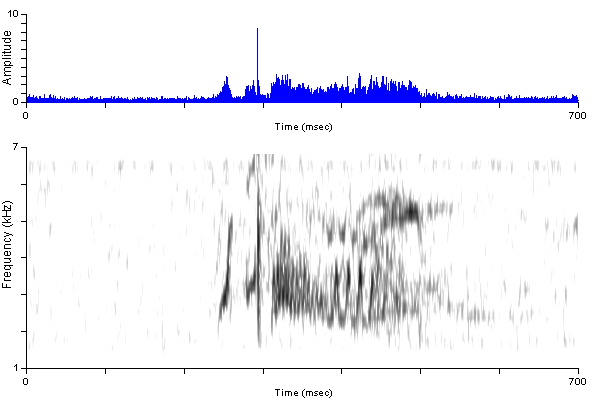
Figure 11.
WIFL "Bew," 7/18/2004, Izaak Walton Road, near Eugene,
Lane County, Oregon. ã
D. A. McCallum.
|
|
Similar sounds. This sound has the same relationship to Fitzbew that WIFL Weeoo has to WIFL Zweeoo. |
|
12. ALFL Churr
Introduction Table of Contents Back to Reference Page
Recording © Arch McCallum

Figure 12.
Two ALFL Churrs, 7/26/2006, Black Balsam (Mountain), 5803
feet elevation, Haywood County, North Carolina. ã
D. A. McCallum.
|
|
Similar sounds. WIFL Churr: Too rare to be characterized, but the initial notes in the two Churrs above appear to be restricted to ALFL. WIFL Weeoo is intermediate between these sounds and ALFL Weeoo. |
|
13. WIFL Churr
Introduction Table of Contents Back to Reference Page
Recording © Arch McCallum
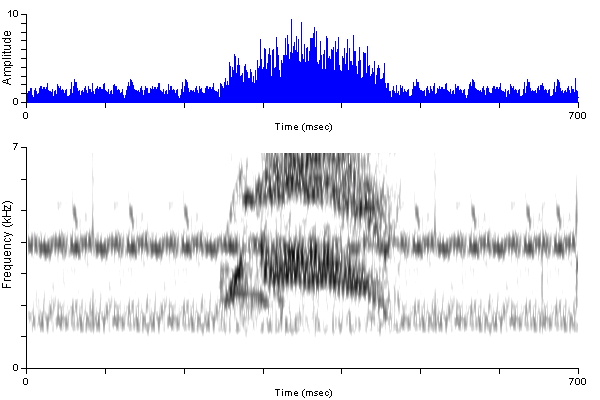
Figure 13.
WIFL Churr, 7/01/2007, Hooper Lane, Henderson County,
North Carolina. ã
D. A. McCallum.
|
|
Similar sounds. ALFL Churr: very similar. WIFL Weeoo has an initial chevron, as does ALFL Weeoo. |
|
14. WIFL Trill
Introduction Table of Contents Back to Reference Page
Recording © Andrew Rush
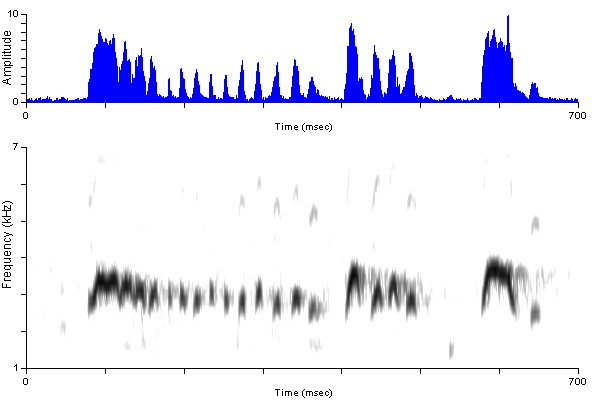
Figure 14.
WIFL Trill, 6/6/2007, Princeton, British Columbia. ã
Andrew Rush, used with permission.
|
|
Similar sounds. ALFL Trill is indistinguishable. Similar-sounding trills are given by Gray and Hammond's Flycatchers. |
|
15. ALFL Trill
Introduction Table of Contents Back to Reference Page
Recording © Arch McCallum
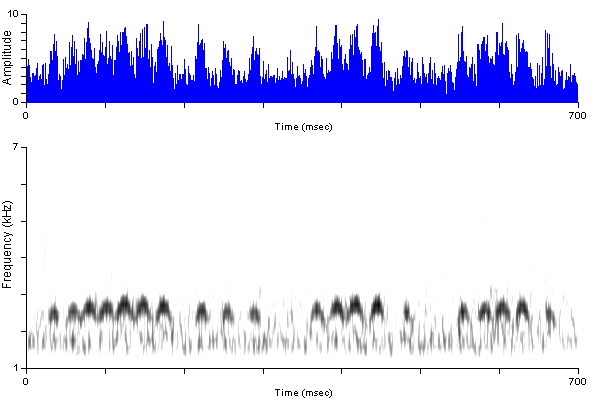
Figure 15.
ALFL Trill, 6/13/1993, Denali State Park, Matanuska-Susitna
Borough, Alaska. ã
D. A. McCallum. This is a low quality recording. Wind was high, and the bird
was distant.
|
|
Similar sounds. WIFL Trill is indistinguishable. Similar-sounding trills are given by Gray and Hammond's Flycatchers. |
|
16. ALFL Pip
Introduction Table of Contents Back to Reference Page
Recording by Donald Borror, © Borror Lab

Figure 16.
ALFL Pip, 8/1/1956, Cutler, Washington County, Maine.
Borror Laboratory of Bioacoustics Cut 2226. ã
Borror Laboratory of Bioacoustics, used with permission.
|
|
Similar sounds. WIFL Whup (=Pip): Usually shorter in duration and lower in frequency, about 1 kHz in example shown here. Also, even the most Pip-like examples of the quite variable WIFL Whup tend to display the asymmetric pitch trend. Pip of Hammond's Flycatcher is quite similar. The ranges of Alder and Hammond's Flycatchers overlap extensively in Alaska. |
|
17. WIFL Pip
Introduction Table of Contents Back to Reference Page
Recording © Andrew Rush
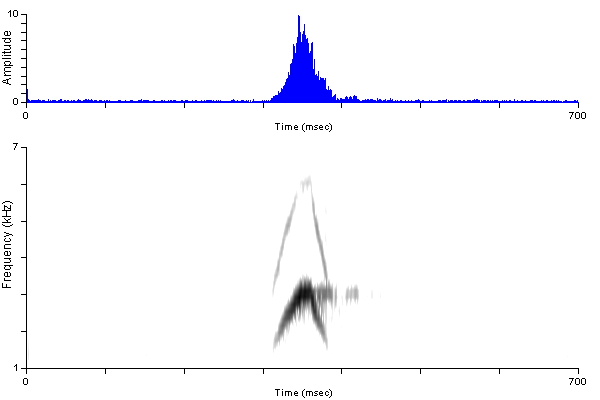
Figure 17.
WIFL Whup (Pip), 6/6/2007, Princeton, British Columbia.
ã
Andrew Rush, used with permission.
|
|
Similar sounds. ALFL Pip: More symmetric, shorter in duration, and higher in pitch than this sound. |
|
18. WIFL Whup
Introduction Table of Contents Back to Reference Page
Recording © Arch McCallum

Figure 18.
WIFL Whup, 7/18/2004, Izaak Walton Road, near Eugene, Lane
County, Oregon. ã
D. A. McCallum.
|
|
Similar sounds. The more drawn-out Whups, like this one, are longer than the Pips of Alder and Hammond's. Duration plus the asymmetric pitch trend give Whup a distinctive aural quality that distinguishes it from most other empid sounds. Acadian Flycatcher call note: similar in form but reaches 6 kHz. |
|
19. WIFL Whit
Introduction Table of Contents Back to Reference Page
Recording © Arch McCallum

Figure 19.
WIFL Whit, 8/2/2007, Izaak Walton Road, near Eugene, Lane
County, Oregon. ã
D. A. McCallum
|
|
Similar sounds. Alder Flycatcher has no Whit in its repertoire. Very similar to Whit notes of Least, Dusky, Gray, and Buff-breasted Flycatchers. "Thicker" and more robust than all of those. Having a partial descending arm makes a WIFL Whit even more distinctive, as this feature is found in none of the Whits of other species. |
|
20. ALFL Double-Peak
Introduction Table of Contents Back to Reference Page
Recording © Arch McCallum

Figure 20.
ALFL Double-Peak, 7/26/2006, Black Balsam (Mountain), 5803
feet elevation, Haywood County, North Carolina. ã
D. A. McCallum.
|
|
Similar sounds. WIFL Double-Peak: Lower in pitch, but otherwise similar, and rare, whereas ALFL Double-Peak is used commonly, and sometimes used for singing (see below). In the two examples I've seen, WIFL Double-Peak begins at the top of the first peak, which should be audible in the field. |
|
21. WIFL Double-Peak
Introduction Table of Contents Back to Reference Page
Recording © Andrew Rush
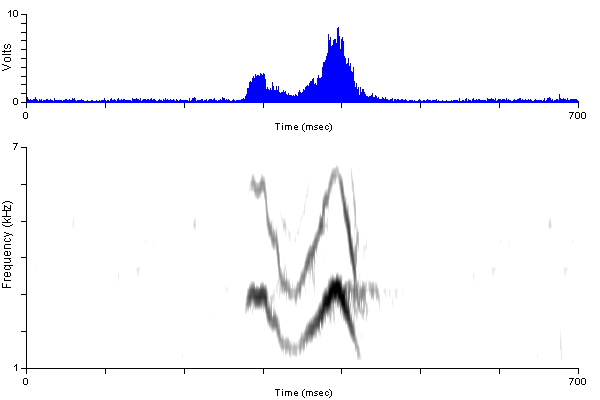
Figure 21.
WIFL Double-Peak, 6/6/2007, Princeton, British Columbia.
ã
Andrew Rush.
|
|
Similar sounds. ALFL Double-Peak: Higher, but other field marks should be sought to confirm identification. Hammond's Flycatcher has an infrequently- heard call, Whezee, which is spectrographically similar. As Hammond's and the Traill's complex are in different clades of Empidonax, these similarities are probably convergent rather than being homologous. |
|
22. ALFL Pip-Weeoo
Introduction Table of Contents Back to Reference Page
Recording © Arch McCallum

|
|
Similar sounds. WIFL Fitzbew, WIFL Whit-Weeoo. |
|
23. WIFL Whit-Weeoo
Introduction Table of Contents Back to Reference Page
Recording © Arch McCallum
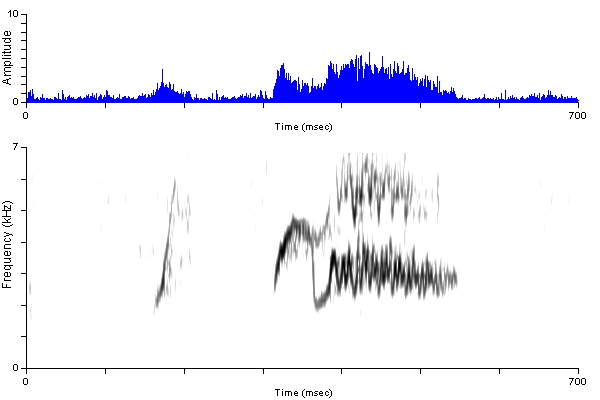
Figure 23.
WIFL Whit and Weeoo,
7/09/2006,
Upper Nutria, McKinley County, New Mexico. ã
D. A. McCallum. These are two independent calls, which are sometimes combined.
In this case, they could have been made by different birds, as two birds were
present, but this combination is common (Sedgwick 2000), and his Figure 2e
shows the two
with equal amplitude, more likely made by the same bird.
|
|
Similar sounds. ALFL Pip-Weeoo: has a Pip not a Whit, and its Weeoo is cleaner. WIFL Fitzbew: has two introductory clicks instead of one, longer in duration. |
|
24. ALFL ComplexCall
Introduction Table of Contents Back to Reference Page
Recording by Donald Borror, © Borror Lab

Figure 24.
ALFL complex call, 8/1/1956, Cutler, Washington County, Maine.
Borror Laboratory of Bioacoustics Cut 2226. ã
Borror Laboratory of Bioacoustics, used with permission. This sample is the
source of the Weeoo in Figure 8.
|
|
Distinguishing features. Of the 3 call types above, Weeoo is the most diagnostic for indentifying ALFL. Churr is not helpful, and Double-Peak differs only quantitatively between the species. |
|
25. ALFL Twitter
Introduction Table of Contents Back to Reference Page
Recording © Arch McCallum

Figure 25.
ALFL variable twitter, 6/13/1993, Denali State Park, Matanuska-
Susitna Borough, Alaska. ã
D. A. McCallum.
|
|
Similar sounds. WIFL undescribed descending twitter. |
|
26. WIFL Twitter
Introduction Table of Contents Back to Reference Page
Recording © Arch McCallum
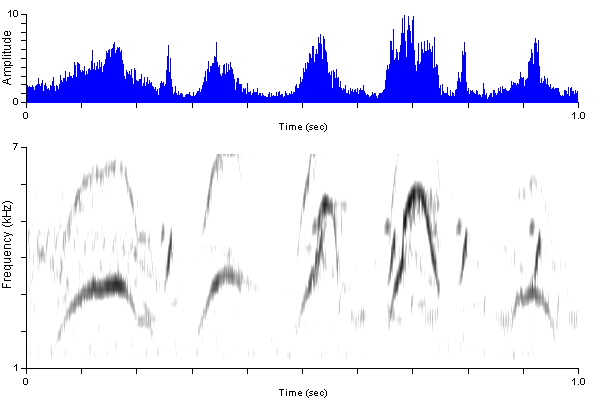
Figure 26.
WIFL variable twitter, 7/01/2007, Hooper Lane, near
Hendersonville, Henderson County, North Carolina. ã
D. A. McCallum.
|
|
Similar sounds. ALFL undescribed descending twitter. The third and fourth notes in this example are clearly related to "Fitz" of Fitzbew. |
All recordings presented here are the property of the recordists and are used here with the permission of the copyright holder. The name of the copyright holder appears above each spectrogram.
Spectrograms, text, design, and source code are the property of AppliedBioacoustics. © 2006-2008 AppliedBioacoustics.